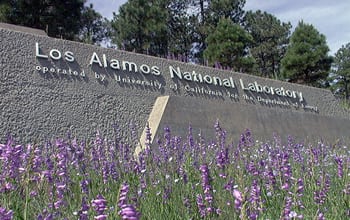
With the United States probing the possibility of thawing the social freeze from the COVID-19 pandemic, the Department of Energy’s Los Alamos and Lawrence Livermore national laboratories plan to start slowly ramping up on-site work this month.
Los Alamos has been in a mission-critical operations posture since March, limiting on-site work to what Director Thomas Mason in late March called “key national security activities.” Under that posture, more employees than not of the New Mexico’s facility’s workforce of about 12,700 are either staying at home or telecommuting.
But this month, according to sources with knowledge of Los Alamos’ plans, management wants to end remote work for some of those people. That includes personnel in Technical Area 55, home of the Plutonium Facility (PF-4), and those working in Technical Area 22, where Los Alamos assembles nuclear detonation systems.
Workers called back to these area will be trained to maintain social distancing where possible, and practice added sanitary procedures before returning to their jobs, according to recent lab plans.
For PF-4, where workers are packed in tight, Los Alamos is developing even more specific guidelines for a safe return to work. Among the issues to be addressed are the queues workers form at the facility’s entrance, where they submit to security sweeps and provide biometric data.
A Los Alamos spokesperson would not comment further this week on the timeline for ramping up operations, but said work at PF-4 has not stopped entirely during the lockdown.
“As was the case for much of March, more than 80 percent of the Laboratory workforce continues to telework from offsite while nearly 20 percent are working on-site — including at PF-4 — to perform mission critical activities,” the lab spokesperson wrote in an email.
PF-4 is where Los Alamos will manufacture plutonium pits: the fissile cores of nuclear weapons. The National Nuclear Security Administration (NNSA) wants Los Alamos to make 10 war-ready pits in 2024, then ramp up to no fewer than 30 pits annually by 2026 and beyond. The cores initially will be for future W87-1 warheads: the planned tip of future silo-based Ground-Based Strategic Deterrent intercontinental ballistic missiles.
Meanwhile, Lawrence Livermore in California aims to have 1,000 workers on-site by the end of the month, the younger of the two nuclear weapon design labs said on its website Wednesday. About 7,000 people work there, normally. The lab slowly started bringing people back last week — a spokesperson would not say how many — when it transitioned out of the minimum safe operations posture it adopted on March 23.
The next people Livermore wants to bring back are those working on “classified, office-based activities in support of priority weapons program activities, including support to the stockpile and modernization programs, along with critical support to the intelligence community,” according to Wednesday’s post. That would be followed by activities including “experimental work and part fabrication” and “high-priority construction projects.”
New Mexico-based Sandia National Laboratories, meanwhile, “has no immediate plans to bring non-essential employees back to the labs,” a spokesperson wrote Wednesday in an email. “About 75% of our workforce will continue to telecommute.”
Sandia is able to test its employees for COVID-19, though Los Alamos and Livermore were not, at deadline Friday for Nuclear Security & Deterrence Monitor.